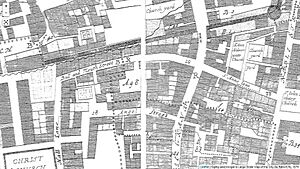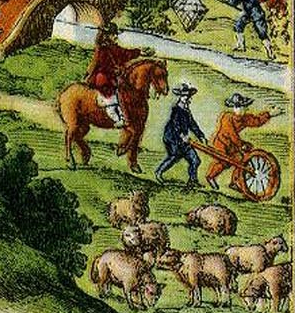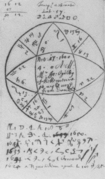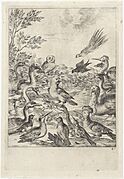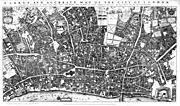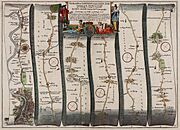John Ogilby facts for kids
Quick facts for kids
John Ogilby
|
|
|---|---|
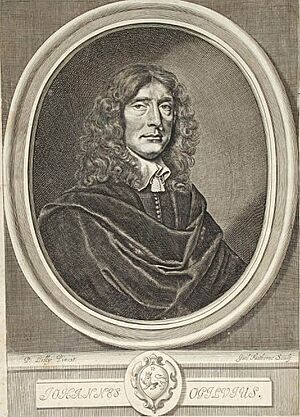
|
|
| Born | 17 November 1600 Kirriemuir (Angus, Scotland)
|
| Died | 4 September 1676 (aged 75) London, England
|
| Occupation |
|
|
Notable work
|
|
John Ogilby (born November 17, 1600 – died September 4, 1676) was a talented Scottish person who did many things. He was a translator, someone who puts on shows (an impresario), a publisher of books, and a mapmaker (cartographer).
Ogilby is famous for his translations of old Roman and Greek stories, like those by Virgil and Homer. He also created the first road atlas of England and Wales that was based on real measurements and drawn to scale. He even started Ireland's first theater in Dublin!
Contents
Life and Work
Early Years (1600–1618)
John Ogilby was born in 1600. We know his exact birth date and time because he once asked an astrologer, Elias Ashmole, to create his horoscope. Ashmole recorded that John was born in Kirriemuir, Scotland, on November 17, 1600, at 4:00 AM.
When he was young, John became an apprentice to a dance teacher in London. He learned a lot and became a very skilled dancer and teacher himself. However, a fall while dancing in a play when he was 18 years old injured his leg. This meant he could no longer be a professional dancer.
Adventures and Challenges (1619−1646)
Not much is known about John Ogilby's life right after his injury. Records suggest he might have fought in wars in Europe. He was even a prisoner of war for a while in Dunkirk.
In 1633, John Ogilby moved to Ireland. He was invited to teach dancing to the family of the Lord Deputy of Ireland, Thomas Wentworth. While in Dublin, Ogilby opened Ireland's very first theater, called the Werburgh Street Theatre. He was also put in charge of all performances in Ireland, meaning he could allow or stop shows. The theater had to close in 1641 because of a rebellion in Ireland. With no more theater work, Ogilby spent his time learning Latin and translating the complete works of the Roman poet Virgil.
Becoming a Writer and Publisher (1647−1660)
John Ogilby returned to England in 1647. His translation of Virgil's work was published in 1648.
In 1650, Ogilby married Christian Hunsdon, a wealthy widow. The next year, he published his famous book, The Fables of Aesop. This book was very popular and was printed five more times in the next 15 years.
After this success, Ogilby learned Greek. He wanted to translate Homer's Iliad, a very important Greek epic poem. He planned for it to be a huge, beautiful book with many pictures. It was a very expensive project, but he didn't get as much support as he hoped. The book was published in 1660, but it had fewer illustrations than he had planned.
Royal Mapmaker and the Great Fire (1661–1676)
When King Charles II returned to the throne in 1660, things got better for Ogilby. In 1661, he was named "Master of the Royal Imprimerie" (King's Printer). He also helped plan the speeches and songs for King Charles II's coronation parade.
A year later, Ogilby was again put in charge of performances in Ireland. He started building a new theater in Dublin. But he soon returned to London in 1664. In 1665, he published a new version of The Fables of Aesop with new illustrations.
In 1666, the Great Fire of London destroyed Ogilby's house, his printing workshop, and most of his books. He lost a lot of money. After the fire, the city of London asked Ogilby and his wife's grandson, William Morgan, to help map out the city again. This was important because many property lines were unclear after the fire. Ogilby created a very accurate map of London.
By 1668, he had a new house and was ready to start printing and publishing again. He then began a series of atlases (collections of maps) about different parts of the world, like China, Japan, Africa, Asia, and America.
In 1671, the King gave Ogilby the special title of Royal Cosmographer. This meant he was the King's official mapmaker. Around age 70, Ogilby started working on his most famous project: Britannia.
Britannia
In 1675, Ogilby published Britannia, which was the first detailed road atlas of England and Wales. This book had 100 maps of major roads. Each map showed the road as a long strip, and there was text with advice for using the map.
Ogilby measured the roads using a special tool called a "way-wiser," which was like a surveyor's wheel. He drew the maps at a scale of one inch to one mile, which was a new idea at the time. The maps included details like hills, bridges, ferries, and the sizes of towns. These new ideas made Ogilby very important in the history of mapmaking.
Death
John Ogilby passed away in September 1676. He was buried in a church in London. In his will, he left everything to his wife and her grandson, William Morgan.
Literary Legacy
After he died, some famous writers like John Dryden and Alexander Pope made fun of Ogilby's translations. They said his writing wasn't as good as others. For a long time, people didn't think much of his work.
However, since the mid-1900s, people have started to look at Ogilby's work again, especially his versions of Aesop's Fables. Many now agree that his fables were very well done. They even helped bring back interest in fables as a way to tell stories and share ideas about the world.
Gallery
See also
- Britannia Depicta
- Gough Map
- Christopher Saxton
- John Ogilvy (disambiguation)


